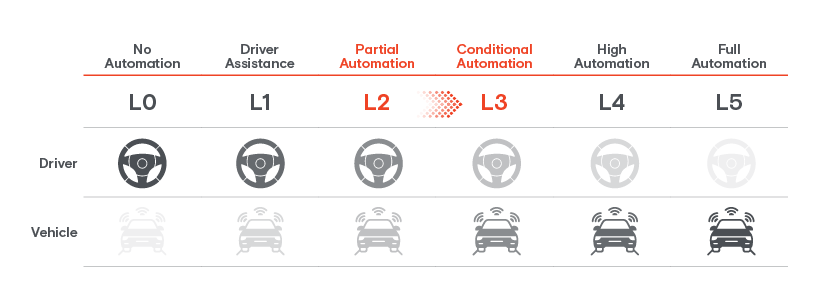Autonomous Vehicles: A Critical Focus for AI
In Part One, we talked about how the market for AI-powered automotive solutions is expected to increase over ten-fold by 2025, the areas of opportunity for advancing the in-cabin experience, and the importance of having unbiased training data for AI models. In Part Two, we’ll cover key components of the out-of-car experience, rounding out our comprehensive take on where to focus investments in the autonomous vehicles race.The Road to Autonomy
 Autonomous vehicles continue to dominate the conversation when it comes to out-of-car experiences. While the push is to reach the highest levels of autonomy (level 5), there are many gradual progressions of how AI impacts the out-of-car experience on the road to get there. Smart cars powered by AI require higher levels of computer vision and computing power – with sensors from radars and cameras delivering massive amounts of data every second to process things like hazardous road conditions, objects in the road, and road signs.
Autonomous vehicles need not only to understand their passengers and drivers but to be able to navigate a complex world. This is a safety-critical use case for AI, where there’s very little room for error. While the process of full automation has been gradual, the slower process helps build trust with consumers as automotive companies work through the different level classifications of autonomy. Thanks to recent research in computer vision ML models, the AI-powered self-driving opportunities are heavily focused on computer vision with LiDAR, video object tracking, and sensor data. These help cars “see” and “think” when driving from point A to point B. Data annotation services that help train models to perform include:
Point Cloud Labeling (LiDAR, Radar)
Understand the scene in front of and around the car by identifying and tracking the objects in the scene. Merge point cloud data and video streams into one scene to be annotated. Point cloud data helps your model understand the world around the vehicle.
2D Labeling including Semantic Segmentation
Help your model get a fine-tuned understanding of the input from its visual light cameras. Find a data partner that can help with scalable bounding boxes or highly-detailed pixel masks created for your custom ontology.
Video Object and Event Tracking
Your model has to understand how objects move through time, and your data partner should assist in labeling temporal events. Track objects in your ontology (like other cars and pedestrians) as they enter and exit the area of interest over many frames of videos and LiDAR scenes. It’s critical to maintain a consistent understanding of the object’s identity through the entire video, no matter how often they drop in and out of sight.
Autonomous vehicles continue to dominate the conversation when it comes to out-of-car experiences. While the push is to reach the highest levels of autonomy (level 5), there are many gradual progressions of how AI impacts the out-of-car experience on the road to get there. Smart cars powered by AI require higher levels of computer vision and computing power – with sensors from radars and cameras delivering massive amounts of data every second to process things like hazardous road conditions, objects in the road, and road signs.
Autonomous vehicles need not only to understand their passengers and drivers but to be able to navigate a complex world. This is a safety-critical use case for AI, where there’s very little room for error. While the process of full automation has been gradual, the slower process helps build trust with consumers as automotive companies work through the different level classifications of autonomy. Thanks to recent research in computer vision ML models, the AI-powered self-driving opportunities are heavily focused on computer vision with LiDAR, video object tracking, and sensor data. These help cars “see” and “think” when driving from point A to point B. Data annotation services that help train models to perform include:
Point Cloud Labeling (LiDAR, Radar)
Understand the scene in front of and around the car by identifying and tracking the objects in the scene. Merge point cloud data and video streams into one scene to be annotated. Point cloud data helps your model understand the world around the vehicle.
2D Labeling including Semantic Segmentation
Help your model get a fine-tuned understanding of the input from its visual light cameras. Find a data partner that can help with scalable bounding boxes or highly-detailed pixel masks created for your custom ontology.
Video Object and Event Tracking
Your model has to understand how objects move through time, and your data partner should assist in labeling temporal events. Track objects in your ontology (like other cars and pedestrians) as they enter and exit the area of interest over many frames of videos and LiDAR scenes. It’s critical to maintain a consistent understanding of the object’s identity through the entire video, no matter how often they drop in and out of sight.











